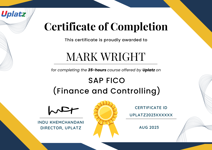SOAP and REST API Course
Self-paced videos, Lifetime access, Study material, Certification prep, Technical support, Course Completion Certificate
Uplatz
Summary
- Certificate of completion - Free
Add to basket or enquire
Overview
Uplatz provides this comprehensive course on SOAP and REST API. It is a self-paced course with recorded video lectures. You will be awarded Course Completion Certificate at the end of the course.
SOAP API (Simple Object Access Protocol)What is SOAP?SOAP is a protocol used for exchanging structured information between systems over a network. It relies on XML to format messages and typically uses HTTP or SMTP for communication.
How SOAP Works:A client sends a SOAP request in XML format to a SOAP server.
The server processes the request and sends back an XML-formatted response.
Communication is done using a WSDL (Web Services Description Language) file, which defines the service operations and message structure.
Protocol-based (strict standards to follow)
Uses only XML for message formatting
Supports WS-Security for encryption and authentication
Built-in error handling through fault elements
Supports stateful and stateless operations
Language and platform-independent
Requires more bandwidth due to XML overhead
REST is an architectural style that uses standard HTTP methods to interact with resources (data) via URLs. It's lightweight, flexible, and commonly used in web services.
How REST Works:A client makes an HTTP request (GET, POST, PUT, DELETE) to a RESTful API endpoint (a URL).
The server processes the request and returns a response, typically in JSON or XML format.
Each URL represents a resource, and HTTP methods define the action on that resource.
Stateless: Each request is independent; no session info stored on the server
Uses standard HTTP methods (GET, POST, PUT, DELETE)
Supports multiple data formats, commonly JSON
Lightweight and fast (less overhead than SOAP)
Scalable and ideal for web and mobile applications
Easy to integrate with modern frontend frameworks
Certificates
Certificate of completion
Digital certificate - Included
Course Completion Certificate by Uplatz
Course media
Description
SOAP and REST API - Course Syllabus
Module 1: Introduction to Web ServicesWhat are Web Services?
Role in application integration
Types of Web Services: SOAP vs. REST
Client-server architecture overview
APIs vs. Web Services
Introduction to SOAP
SOAP Protocol structure
SOAP Envelope, Header, and Body
Creating and consuming a SOAP service
Using WSDL (Web Services Description Language)
SOAP Faults and Error Handling
Tools: Postman, SOAP UI
Hands-on: Build and consume a simple SOAP web service
What is REST and RESTful architecture
Principles of REST (Statelessness, Uniform Interface, etc.)
Resources and HTTP methods (GET, POST, PUT, DELETE, PATCH)
REST URI structure and best practices
Request and response formats (JSON vs. XML)
CRUD operations using REST
Hands-on: Build a RESTful API using Node.js/Python/Java (based on tech stack)
Manual API testing using Postman
Writing and running test cases
Using CURL for API interaction
Testing authentication-protected APIs
Hands-on: Automate basic tests with Postman Collections
Basic API security principles
Authentication methods: Basic Auth, API Key, OAuth 2.0
HTTPS and TLS
WS-Security for SOAP
JWT (JSON Web Tokens) for REST
Hands-on: Secure an API using API keys/OAuth
Versioning in APIs
Pagination and filtering
Rate limiting and throttling
Caching in REST APIs
Error codes and best practices
Comparing performance: SOAP vs. REST
Hands-on: Add pagination and versioning to an existing API
Integrating third-party APIs (e.g., weather, payment gateways)
Consuming public APIs using REST
XML and JSON parsing
Hands-on: Build a small project that consumes external APIs
Who is this course for?
Backend developers who want to build and consume SOAP/REST APIs.
Full-stack developers working on web and mobile applications that rely on APIs.
Engineers transitioning from monolithic to API-driven architectures.
Frontend developers who need to interact with APIs (e.g., React, Angular, or Flutter developers).
Mobile app developers integrating APIs for data exchange.
Professionals responsible for API testing, automation, and validation.
Testers using tools like Postman, SOAP UI, and CURL for API validation.
Engineers managing API deployments, security, and scalability.
Professionals working with microservices and cloud-based API gateways (AWS API Gateway, Azure API Management).
Professionals working on enterprise application integration (EAI).
IT teams maintaining legacy SOAP-based systems while adopting REST APIs.
Architects designing API-based solutions and microservices.
Tech leads making decisions between SOAP and REST for enterprise systems.
Computer science/engineering students learning web services and API development.
Coding bootcamp graduates expanding their backend development skills.
Non-technical roles that need to understand API capabilities for product planning.
Analysts working with third-party API integrations (e.g., payment gateways, weather APIs).
Experts focusing on API security (OAuth, JWT, HTTPS, WS-Security).
Requirements
Passion & determination to achieve your goals!
Career path
- API Developer
- API Tester
- Software Engineer
- Application Developer
- Solution Architect
- Technical Lead
Questions and answers
Currently there are no Q&As for this course. Be the first to ask a question.
Reviews
Currently there are no reviews for this course. Be the first to leave a review.
Legal information
This course is advertised on Reed.co.uk by the Course Provider, whose terms and conditions apply. Purchases are made directly from the Course Provider, and as such, content and materials are supplied by the Course Provider directly. Reed is acting as agent and not reseller in relation to this course. Reed's only responsibility is to facilitate your payment for the course. It is your responsibility to review and agree to the Course Provider's terms and conditions and satisfy yourself as to the suitability of the course you intend to purchase. Reed will not have any responsibility for the content of the course and/or associated materials.


